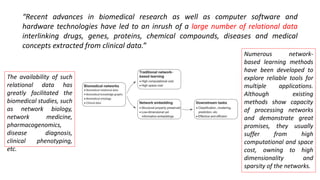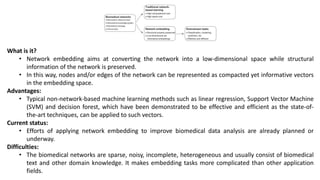Network embedding in biomedical data science
Excerpts from the paper: What is it? Network embedding aims at converting the network into a low-dimensional space while structural information of the network is preserved. In this way, nodes and/or edges of the network can be represented as compacted yet informative vectors in the embedding space. Advantages: Typical non-network-based machine learning methods such as linear regression, Support Vector Machine (SVM) and decision forest, which have been demonstrated to be effective and efficient as the state-of-the-art techniques, can be applied to such vectors. Current status: Efforts of applying network embedding to improve biomedical data analysis are already planned or underway. Difficulties: The biomedical networks are sparse, noisy, incomplete, heterogeneous and usually consist of biomedical text and other domain knowledge. It makes embedding tasks more complicated than other application fields.





















Recommended




























































More Related Content
What's hot (19)






































Similar to Network embedding in biomedical data science (20)








































More from Arindam Ghosh (19)






































Recently uploaded (20)


























Network embedding in biomedical data science
- 1. Network embedding in biomedical data science Chang Su, Jie Tong, Yongjun Zhu, Peng Cui & Fei Wang Briefings in Bioinformatics December 2018 https://doi.org/10.1093/bib/bby117 Journal Club 01-Feb-2019
- 2. “Recent advances in biomedical research as well as computer software and hardware technologies have led to an inrush of a large number of relational data interlinking drugs, genes, proteins, chemical compounds, diseases and medical concepts extracted from clinical data.” The availability of such relational data has greatly facilitated the biomedical studies, such as network biology, network medicine, pharmacogenomics, disease diagnosis, clinical phenotyping, etc. Numerous network- based learning methods have been developed to explore reliable tools for multiple applications. Although existing methods show capacity of processing networks and demonstrate great promises, they usually suffer from high computational and space cost, owning to high dimensionality and sparsity of the networks.
- 3. Efficient analysis of these networks heavily relies on the ways how networks are represented. Often, a discrete adjacency matrix is used to represent a network, which only captures neighboring relationships between vertices. Indeed, this simple representation cannot embody more complex, higher-order structure relationships, such as paths, frequent substructure etc. As a result, such a traditional routine often makes many network analytic tasks computationally expensive and intractable over largescale networks. --Zhang, Daokun, et al. "Network representation learning: A survey." IEEE transactions on Big Data (2018).
- 4. What is it? • Network embedding aims at converting the network into a low-dimensional space while structural information of the network is preserved. • In this way, nodes and/or edges of the network can be represented as compacted yet informative vectors in the embedding space. Advantages: • Typical non-network-based machine learning methods such as linear regression, Support Vector Machine (SVM) and decision forest, which have been demonstrated to be effective and efficient as the state-of- the-art techniques, can be applied to such vectors. Current status: • Efforts of applying network embedding to improve biomedical data analysis are already planned or underway. Difficulties: • The biomedical networks are sparse, noisy, incomplete, heterogeneous and usually consist of biomedical text and other domain knowledge. It makes embedding tasks more complicated than other application fields.
- 5. In the network embedding space, the relationships among the nodes, which were originally represented by edges or other high-order topological measures in graphs, is captured by the distances between nodes in the vector space, and the topological and structural characteristics of a node are encoded into its embedding vector. An example is shown in Fig. After embedding the karate club network into a twodimensional space, the similar nodes marked by the same color are close to each other in the embedding space, demonstrating that the network structure can be well modeled in the two-dimensional embedding space. Ref.: Cui, Peng, et al. "A survey on network embedding." IEEE Transactions on Knowledge and Data Engineering (2018). Basic idea: Embed nodes so that distances in embedding space reflect node similarities in the original network.
- 6. A non-attributed network is also known as homogeneous network, of which all nodes and edges belong to a unique type, respectively. The attributed networks, also known as heterogeneous networks, allow nodes and/or edges to belong to multiple types.
- 7. Table: Network embedding models surveyed in this study.
- 8. Table: Open-source software packages of the network embedding techniques.
- 9. Applications in biomedical data science Table: Biomedical applications of network embedding surveyed in this study. The use of network embedding for biomedical data analysis is recent and not thoroughly explored.
- 10. Drug repositioning: Computational drug repositioning, also known as drug repurposing, is a promising and efficient tool for exploring new usage for existing drugs to save drug development cost and increase productivity. Drugs bind with target proteins and affect their downstream activity, consequently lead to impact on human body to treat the disease. A drug repositioning tool usually aims at predicting unknown drug–target or drug–disease interactions.
- 11. A network integration approach for drug-target interaction prediction and computational drug repositioning from heterogeneous information. -- Luo, Yunan, et al. Nature communications 8.1 (2017): 573. • Proposed DTINet by extending diffusion component analysis (DCA) by separately performing random walk with restart (RWR) on drug–drug, drug–disease, drug side effect and drug similarity networks for drug embedding and on protein–protein, protein–disease and protein similarity networks for target protein embedding. After that, DTINet projected drugs into the embedding space of target proteins and made prediction based on geometric proximity. • Developed a computational pipeline, called DTINet, to predict novel drug–target interactions from a constructed heterogeneous network, which integrates diverse drug-related information. • DTINet focuses on learning a low-dimensional vector representation of features, which accurately explains the topological properties of individual nodes in the heterogeneous network, and then makes prediction based on these representations via a vector space projection scheme. • DTINet achieves substantial performance improvement over other state-of-the-art methods for drug–target interaction prediction.
- 12. Large‐scale extraction of drug–disease pairs from the medical literature. -- Wang, Pengwei, et al. Journal of the Association for Information Science and Technology 68.11 (2017): 2649-2661. • Proposed to detect unknown drug–disease interactions from the medical literature by using neuro-linguistic programming (NLP) and network embedding techniques. • Using treatment and inducement drug–disease pairs extracted from 27 million PubMed articles, they first constructed a heterogeneous network. • They next expanded the network embedding method, LINE, by modifying the 1st-order proximity to encode treatment and inducement relations as positive and negative effects to the objective function, respectively. • The result showed that the embeddings lead to significant improvement in predictions of both types of drug–disease interactions.
- 13. Adverse drug reaction analysis: An adverse drug reaction (ADR) is defined as any undesirable effect from the medical use of drugs beyond its anticipated therapeutic effects that occurs at a usual dosage. The study of ADRs is the concern of drug development especially before a drug is launched on clinical application. Detecting potential ADRs is always time consuming and expensive. To address this, computational methods based on network embedding have been introduced to ADR analysis.
- 14. Large-scale structural and textual similarity-based mining of knowledge graph to predict drug–drug interactions. -- Abdelaziz, Ibrahim, et al. Web Semantics: Science, Services and Agents on the World Wide Web 44 (2017): 104-117. • Tiresias, a large-scale similarity-based framework that predicts DDIs through link prediction. • Tiresias takes in various sources of drug-related data and knowledge as inputs, and provides DDI predictions as outputs. • The process starts with semantic integration of the input data that results in a knowledge graph describing drug attributes and relationships with various related entities such as enzymes, chemical structures, and pathways. • The knowledge graph is then used to compute several similarity measures between all the drugs in a scalable and distributed framework. • The resulting similarity metrics are used to build features for a large-scale logistic regression model to predict potential DDIs.
- 15. Exploiting ontology graph for predicting sparsely annotated gene function. -- Wang, Sheng, et al. Bioinformatics 31.12 (2015): i357-i364. • Proposed clusDCA to predict gene function, by applying diffusion component analysis (DCA) to gene–gene interaction and GO to learn low-dimensional representations for genes and GO labels, respectively. • Based on such embedding results, they trained a projection model from gene space to GO space such that genes geometrically closed to their known GO labels. • It bridges latent gene features and GO labels and results in desirable prediction of sparsely annotated gene functions. Genomics Data Analysis
- 16. Geometric de-noising of protein-protein interaction networks. -- Kuchaiev, Oleksii, et al. PLoS computational biology 5.8 (2009): e1000454. • Proposed an embedding algorithm based on multidimensional scaling (MDS) for PPI network de- noising. • By using the embeddings of proteins, they predicted new PPIs and assessed the confidence of existing PPIs. Proteomics Data Analysis
- 17. miRNA-Disease Association Prediction with Collaborative Matrix Factorization. -- Shen, Zhen, et al. Complexity 2017 (2017). • Developed CMFMDA that introduced matrix factorization to bipartite miRNA-disease network for embedding to predict new associations. • In CMFMDA, miRNA functional similarity and disease semantic similarity were involved in factorization in terms of regularizations to improve embedding. • The evaluation was performed to discover esophageal neoplasms-related miRNAs that were previously confirmed by miR2Disease and dbDEMC. • The results showed that CMFMDA can outperform other computational methods. Transcriptomics Data Analysis
- 18. Challenges Data quality: Unlike other domain where the data are clean and well structured, networks constructed from the biomedical data are usually noisy and incomplete. Local and global: • Performances of the network embedding model and its downstream tasks rely on the type of structural property to preserve. • Preserving local property will gather connected nodes in the embedding space, while preserving global property will project topologically similar (even far separated) nodes together. • Designing embedding method by properly considering local and global structure properties according to application scenarios is an important aspect that will require the development of novel solutions.
- 19. Challenges Network evolution: • Networks are always not static, especially in the biomedical domain. • Existing network embedding models mainly focused on the static networks, and the settings of network evolution were overlooked. • To learn embeddings for a dynamic network, existing methods should be trained repeatedly for each timestamp, which is definitely time consuming and may not capture the temporal properties. • Therefore, most of the existing network embedding methods cannot be directly applied to evolving biomedical networks.
- 20. Challenges Domain complexity: • Different from network embedding application in other domains, the issue on biomedicine and health care is much more complicated. • For example, in a biomedical network, each interaction between entities usually represents a complex genetic, pathological or pharmacological event or process, and there is usually no complete knowledge on how it progresses. • When applying an embedding model, the biomedical domain knowledge is also needed to better understand the network structure.
- 21. Opportunities Local and global trade-off embedding Dynamic embedding Text-associated embedding Domain-knowledge-associated embedding







